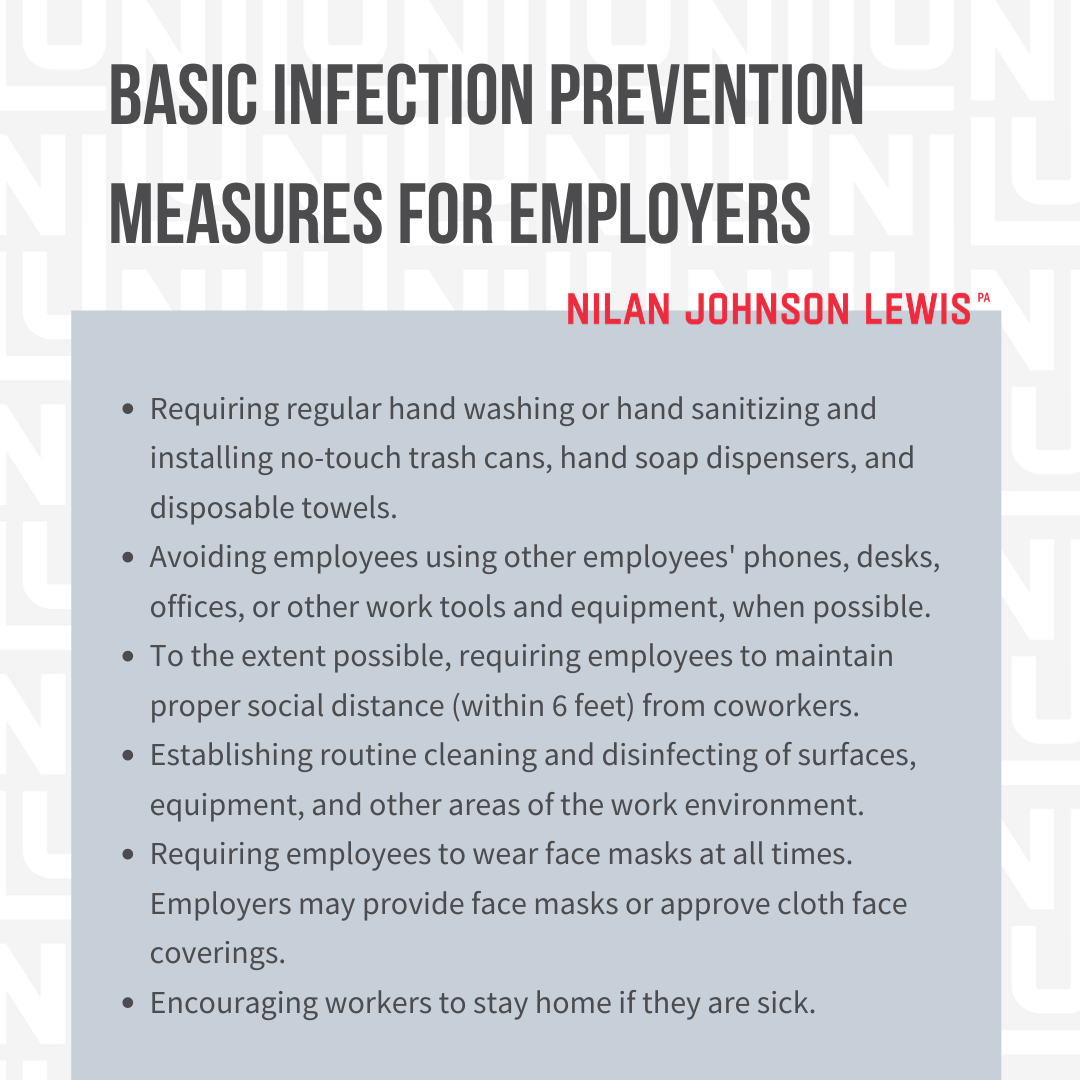Posted May 1st, 2020 in Top Stories, Legal Insights with Tags COVID-19 for Employers, COVID-19
Employer Liability When Workers Contract COVID-19
A significant concern for employers is potential liability to employees who contract COVID-19 at work – either employees in essential businesses who continued to work or employees who may be called back to work after restrictions are eased.
The Role of Workers’ Compensation
In all but the most unusual circumstances, an employer is immune from suit by an employee who suffers a workplace injury or occupational disease. In such situations, the employee’s exclusive remedy is to file a claim with her employer’s workers’ compensation carrier. Of course, these are not usual circumstances and, absent legislative action, most state’s workers’ compensation statutes will not cover illness or death resulting from COVID-19, making employers at least potentially liable if their employees become sick at work. By taking reasonable measures, including following state and federal regulations and guidelines, employers can achieve the dual goals of making their workplaces safe for employees and reducing their liability exposure.
Workers compensation statutes vary by state, but in most jurisdictions, communicable diseases are only covered by workers compensation statutes if (1) the particulars of the job make the risk of infection greater than the risk borne by the public generally, and (2) the employee contracts the disease in the course of her employment. Although the first of these factors may not prove difficult to overcome, especially for those who are exempted from stay-home orders because they are considered essential workers, the second could be much more difficult to satisfy, especially in areas with widespread community infection.
Lawmakers increasingly recognize the possibility that essential workers who jeopardize their wellbeing to provide necessary services may not be compensated if they become ill from COVID-19. Several states have enacted or are considering laws that create a statutory presumption that essential workers—or at the very least, public safety workers—who contract COVID-19 were infected in the course of their employment.
Despite these laws, workers compensation insurance may not be an available remedy for workers whose jobs do not create a heightened risk of infection, or for whom there is no statutory presumption of compensability. In such cases, employers will not be shielded by the workers’ compensation exclusivity bar and could be sued by their employees for negligence. Even in situations where workers compensation is an available remedy, there are exceptions to the exclusivity bar for an employer’s intentional or willful and wanton conduct, which further exposes employers to lawsuits by sickened employees.
Lawsuits Against Employers
At this very early stage, even while the bulk of the American workforce is idled at home, there have been numerous COVID-19 related lawsuits filed against employers regarding employee safety:
- Evans v. Walmart, Illinois Circuit Ct., April 6, 2020: lawsuit by the estate of a deceased employee, alleging he contracted COVID-19 at work. Claims include negligence and willful and wanton misconduct on the part of Walmart, for failing to provide sufficient protection despite knowing that employees were exhibiting possible symptoms of COVID-19.
- Rural Community Workers Alliance v. Smithfield Foods,D. Missouri, April 23, 2020: class action by employees exposed to COVID-19 at Smithfield meat processing plants, including claims of public nuisance and breach of duty to provide a safe workplace.
- Alaska State Employees v State of Alaska, Alaska Superior Court, March 24, 2020: class action on behalf of all state employees alleging refusal to allow telecommuting, and failure to provide PPE or to ensure social distancing at work.
- Braswell, et al. v. United States of America, U.S. Court of Federal Claims, March 27, 2020: employees of Federal agencies, such as the Bureau of Prisons, Department of Veterans Affairs, and the Department of Agriculture, seeking hazard pay for exposure to COVID-9.
Lawsuits have also been filed by employees of cruise providers such as Celebrity Cruises and Princess Cruises; however, because those claims rely heavily on maritime law, they have less applicability to the potential risks faced by most employers.
An Uphill Battle
As more businesses seek to reopen, a sharp increase in injury lawsuits by employees is likely. However, there are calls for relief from litigation, including an April 27, 2020, statement by Senate Majority Leader Mitch McConnell:
While our nation is asking everyone from front-line healthcare professionals to essential small-business owners to major employers to adapt in new ways and keep serving, a massive tangle of federal and state laws could easily mean their heroic efforts are met with years of endless lawsuits. We cannot let that happen. Our nation is facing the worst pandemic in over a century and potentially the worst economic shock since the Great Depression. Our response must not be slowed, weakened, or exploited to set up the biggest trial lawyer bonanza in history. The brave healthcare workers battling this virus and the entrepreneurs who will reopen our economy deserve strong protections from opportunistic lawsuits.
Legislative proposals to reduce an influx of lawsuits could include a heightened causation standard for employees who claim to have been sickened at work and a “safe harbor” for employees who require workers to wear masks and practice social distancing.
Even if lawsuits are brought, the difficulty of establishing when and where an employee contracted the virus will, in most cases, make such lawsuits untenable. There are, however, circumstances in which they could be maintained. For instance, if a large outbreak occurred at a factory in a rural community with few or no other instances of infection, an infected employee could establish a preponderance that they contracted the disease at the factory. Alternatively, a plaintiff might establish that they only ever left their home to go to work, in which case they might persuade the fact finder that it is more likely than not that they contracted the virus at work. To avoid liability, it is important that employers take reasonable measures to provide a safe and healthy workplace, including following all state and federal regulations and guidelines.
Safe Practices are Essential to Reopening
OSHA’s “Guidance on Preparing Workplaces for COVID-19” is a good resource on how to reduce workers’ risk of exposure. Although the particulars of each workplace require different measures, reasonable precautions include:
- Identifying where exposure may occur in parking garages, building entry, elevator/stairs, and shared office spaces; and implementing controls to address the risk.
- Identifying non-occupational risk factors at home and in the community setting, including exposure while using public transportation, to better understand exposure to community spread cases.
- Considering alternating work shifts to reduce the total number of employees in the office.
- Implementing safe workplace practices, such as:

Additionally, OSHA recommends that employers develop an infectious disease preparedness and response plan, implement basic infection prevention measures, and incorporate policies and procedures for prompt identification and isolation of sick people. Once these documents are prepared, employers should communicate to employees all the steps it has taken to alleviate risk of exposure to COVID-19.
As stay-home orders begin to expire, and more Americans return to work, it is safe to assume that infections will continue to occur. By taking proactive measures to reduce the risk of workplace infections, employers will minimize their liability exposure while simultaneously making their employees safe at work.

